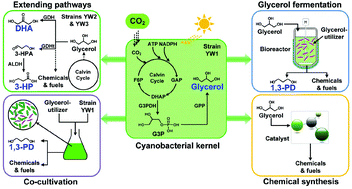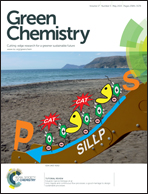Production of C3 platform chemicals from CO2 by genetically engineered cyanobacteria†
Abstract
Platform chemicals can be readily converted into various value-added chemicals and fuels. Photosynthetic production of platform chemicals directly from CO2 by cyanobacteria, in the presence of sunlight, holds promise for addressing global energy and environmental concerns. Herein, we report the photosynthetic production of C3 platform chemicals using engineered Synechococcus elongatus PCC7942 as the kernel. The engineered S. elongatus strain YW1 expressing glycerol-3-phosphatase produced a C3 intermediate, glycerol, with a high concentration of 1.17 g L−1 and a maximum production rate of 7733 μg L−1 H−1. Strain YW1 could serve as the kernel for the production of various C3 chemicals. By extending heterologous pathways in the cyanobacterial kernel, the carbon flux was further channelled to produce two platform chemicals: dihydroxyacetone by introducing glycerol dehydrogenase and 3-hydroxypropionic acid by introducing glycerol dehydratase and aldehyde dehydrogenase. Co-cultivation of the cyanobacterial kernel and another microbe, Klebsiella pneumoniae, was also performed to convert the C3 intermediate produced from CO2 to 1,3-propanediol, an important monomer for biodegradable material production. Besides direct photosynthetic production and co-cultivation, we demonstrated that glycerol produced by the cyanobacterial kernel can be used as a fermentation feedstock after simple concentration. The production processes presented here display great potential for carbon capture and storage and for sustainable production of chemicals and fuels.


 Please wait while we load your content...
Please wait while we load your content...